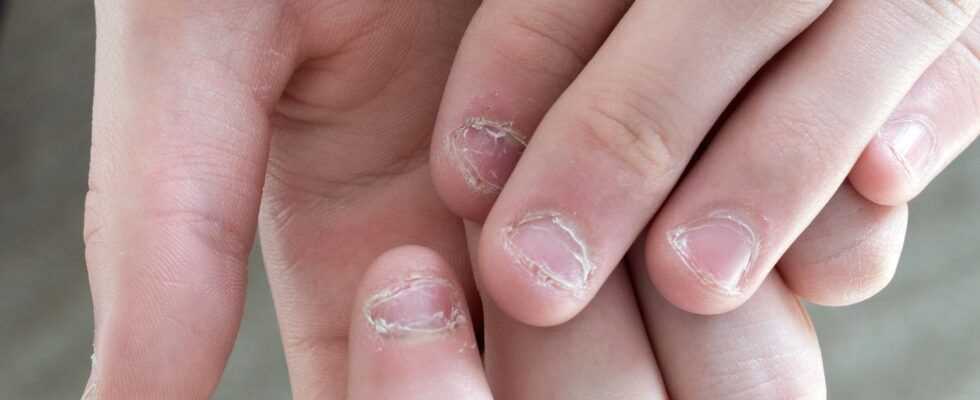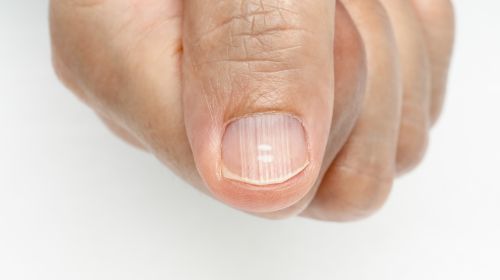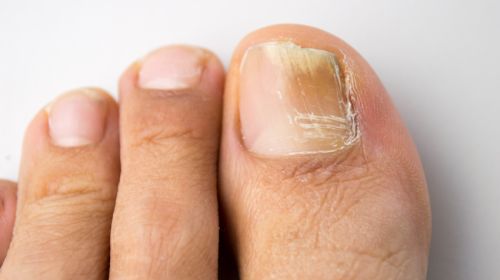Toenails and fingernails can change in many ways. Often there is a lack of nutrition or incorrect nail care behind white spots, transverse or longitudinal grooves. However, infections such as nail fungus or serious diseases can also manifest themselves through nail changes.
- If the nails become discolored or deformed, the cause should be investigated.
- © iStock.com/OlgaVolodina
Only a dermatologist can make the exact diagnosis and choose the best treatment option. Therefore, you should definitely see a doctor at the first signs of severe nail changes. The faster the cause is identified, the more effective the treatment is.
Nail fungus or bacterial infection?
Bacteria in the area of the fingers and toes can cause painful illnesses. Streptococci, more rarely also staphylococci, are the cause of the so-called circulation (medical term: bulla repens). It is a superficial inflammation in the area of the fingertips or toes. The circulation can be recognized by a purulent blister on the toe or finger, which wraps around the affected fingertip or toe and the area around which is red. Depending on how badly the nail bed is affected, the nail can even come off.
In contrast, inflammation of the nail wall (paronychia) is usually caused by an infection with staphylococci. If this moves into the depth of the affected finger or toe, the doctor speaks of a panaritium (deep soft tissue infection).
Wounds are often the entry point for pathogens. For example, if you work in the garden with a hoe and spade and only wear light sandals, you run the risk of injuring yourself. Injuries can also easily occur during nail care.
Caution: Diabetics and people who have to wear closed shoes with a high proportion of plastic or rubber at work or at leisure have a higher risk of infections by bacteria and of course also fungi. The reddened or even pus-filled blisters on the toe or fingers can cause severe pain and limit mobility. If the infection is not treated as quickly as possible, it can spread further and further into deeper tissue layers.
The biggest risk factors for nail fungus
Lifeline / Wochit
Thickening and discoloration due to psoriasis and nail fungus
Yellow, brown or gray discoloration on the nails can not only indicate nail fungus, but can also be a symptom of nail psoriasis (psoriasis).
In both diseases, a thick layer of crumbly horn material sometimes forms. In order to be able to properly treat the toenails or fingernails, the dermatologist must clarify what it is using a so-called nail biopsy. To do this, the doctor scrapes a piece of the infected nail tissue, as in the diagnosis of nail fungus, and examines it under the microscope. This process is not associated with pain for the patient.
Read diseases on the nails
In addition to diseases of the nail plate, systemic diseases such as diabetes mellitus, poisoning or circulatory disorders can also be read on the nail. Other changes in the shape and color of the nail have harmless causes. For example, washing your hands too often dries out your fingernails and makes them brittle.
Frequent nail changes and their possible meaning:
Yellowing of the nails
In heavy smokers, nicotine not only stains the teeth, but also the fingers and nails yellow. Colored cosmetic nail polishes can also lead to such discolouration if, for example, no base coat is used. Certain respiratory diseases such as chronic bronchitis and psoriasis vulgaris are also more often associated with yellow nails. In addition, the yellow to brown color of fingernails or toenails is a symptom of nail fungus.
Hazy white nails
Cloudy white nails, where the nail moon is not visible ("frosted glass nails"), can be congenital. However, if complete clouding occurs in a person whose nails used to have a normal, rosy appearance, severe liver disease (cirrhosis of the liver) can be the cause. White spots, dots and grooves (see below) also arise in connection with nail fungus. In addition, incorrect nail care sometimes leads to such damage to the nail plate.
Gray discolouration
Gray discolored nails, which are also rough and brittle, usually indicate a lack of vitamins, zinc or iron. In addition to a balanced diet, those affected should take appropriate vitamin and mineral supplements for a while. For a precise diagnosis of the deficiency nutrient, a visit to the doctor with a laboratory blood test is recommended.
White spots, spots, longitudinal or transverse grooves
A deficiency symptom can also be behind white dots on the nails. Most of the time, however, they are on one mechanical load or injury attributed. White horizontal stripes on the other hand, it can occur when there is a lack of protein or after serious infections. A congenital cornification disorder is sometimes on white vertical stripes to recognize. White spots are also caused by nail fungus.
Light brown to blackish discolouration
Light brown to blackish discoloration under the nail plate usually occurs with a bruise (hematoma), for example due to a bruise. However, such discoloration can also hide psoriasis ("oil spot nails") or even malignant skin cancer (malignant melanoma). If an injury can be excluded, a thorough diagnosis by a dermatologist should be made.
Thickening, curvature (watch glass nail)
Some serious internal diseases also leave their mark on the fingernails and toenails. For example, one observes nail changes such as heavily thickened, curved nails ("watch glass nails") in severe heart, liver and lung diseases. In addition, those affected have flared finger ends ("drumstick fingers").
Dented nail surfaces (spoon nail)
So-called "spoon nails", ie dented nail surfaces, are caused by a lack of vitamins and iron. An illness with reduced blood flow to the fingers and toes, called Raynaud's syndrome, can also be the cause.
-

Changes to the fingernails and toenails can indicate a nail fungus infection. With ten questions from our check, you can check whether you have nail fungus.
Test now!
Small dimples (spotted nail)
As spotted nails (Onychia punctata) are called nails with small dimples on one or more nail plates. These nail changes are particularly common in psoriasis. Other causes can be eczema or alopecia areata.
Cross grooves
Cross grooves in the nail surface occur with hormonal fluctuations, certain infections or as side effects when taking anti-cancer drugs. Other medicines can also damage or even detach the nail, such as antibiotics. Neurodermatitis patients sometimes have transverse grooves on individual nails.
Longitudinal grooves
Longitudinal grooves in the nail surface are usually not due to pathological causes, but are considered a normal sign of aging. The symptoms sometimes appear from the age of 35.
Chipped nail edge, split fingernails
Splintered and split nail edges mostly result from external influences such as softening, degreasing soaps, aggressive cleaning agents, cosmetic nail polish or nail polish remover. It is advisable to avoid frequent hand washing, always wear gloves when cleaning and washing dishes, and regularly give the nails breaks from painting.
Optimal nail care: how it works
Lifeline / Wochit
Mechanical stress, such as playing an instrument or occupational stress, can also lead to nail splintering. From a medical point of view, there may also be an iron deficiency behind it.
Brittle or soft nails
External causes are frequent washing, contact with degreasing substances and household chemicals as well as frequent use of nail polish and remover (see above). A lack of various vitamins and minerals – for example vitamin A, B vitamins such as biotin, calcium and iron – is also conceivable. In addition, a Thyroid disease to brittle or soft nails.
-

Constantly tired or wide awake? Do you gain weight without eating too much? The self-test shows whether an over or under function of the thyroid gland could be behind it!
for self-test
Peel off the nail plate
The nail loosens during onycholysis from the edge of the fingertip, the detached area appears white. External causes are above all long contact with water and soap or detergent solutions. Too much stress or too intensive nail cleaning under the edge and diseases can be behind a nail plate detachment. These include various thyroid disorders, diabetes and various skin diseases and nail fungus. As part of pregnancy, the nail is also detached from time to time.
Characteristic changes in nail fungus
Many of the nail changes mentioned above occur in connection with a nail fungus infection. The faster it is diagnosed, the more effective and easier the treatment. Click through the overview of symptoms:


